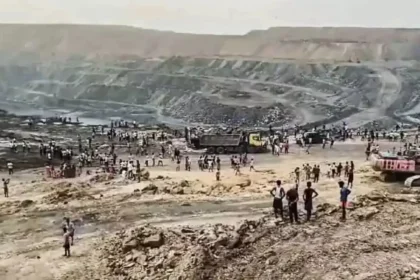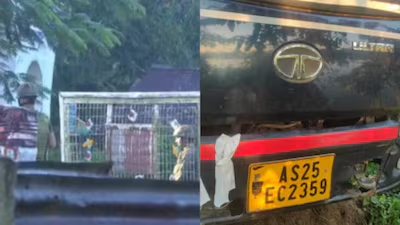Mumbai Builder Dies by Suicide, Citing Harassment by Money Lenders: Police Report
The Tragic Demise of a Mumbai Builder – A City in Shock
Mumbai, the financial heartbeat of India, was rocked this week by the tragic suicide of a local builder who reportedly took his own life due to relentless harassment by money lenders. This incident, which occurred in a suburban neighborhood, has brought to light the darker undercurrents of Mumbai’s booming real estate industry—where ambition often collides with financial pressure, and dreams are crushed under the weight of informal lending systems.
According to the Mumbai Police, the builder, identified as 52-year-old Rajiv S., was found dead in his apartment. A suicide note retrieved from the scene reportedly details the emotional and financial torment he endured at the hands of private lenders. The note, now part of an ongoing investigation, accuses multiple individuals of extortion, coercive recovery tactics, and threats.
Family members and close associates confirmed that Rajiv had been under intense stress for the past few months. Although he was a mid-level builder with several successful residential projects to his name, he had recently faced cash flow issues that pushed him toward borrowing from informal sources. These private lenders, often operating outside legal boundaries, are known to use aggressive methods to recover loans, especially when formal repayments falter.
The Human Cost of Financial Desperation
Colleagues describe Rajiv as a hardworking entrepreneur who was deeply involved in his projects and maintained a close-knit team of engineers, architects, and contractors. “He had a vision, but the last six months were hell for him,” said a former partner who requested anonymity. “He was under constant pressure. These weren’t your regular bankers. These people would call at odd hours, show up at his site, and make veiled threats.”
In his suicide note, Rajiv reportedly pleaded for justice, urging authorities to take stringent action against those responsible for his plight. The letter, emotional yet composed, sheds light on a man pushed to the edge—not just by mounting debt, but by fear, intimidation, and helplessness.
Police Action and Public Reaction
Police have launched a probe under Section 306 of the Indian Penal Code (abetment to suicide) and are currently interrogating multiple suspects named in the suicide note. Sources confirm that call records, financial transactions, and CCTV footage from Rajiv’s office and home are being scrutinized. “No one is above the law,” said DCP Meenakshi Patil. “We are treating this as a serious case of mental and financial abuse leading to suicide.”
Public reactions have ranged from sorrow to outrage. Social media is abuzz with messages of condolence and demands for a crackdown on unregulated money lending. Activists have renewed calls for stricter regulations, greater borrower protection, and a public grievance mechanism to report harassment by informal lenders.

The Hidden Threat of Informal Lending in Real Estate
Mumbai’s real estate sector, valued in the billions, is often driven by rapid transactions, land acquisitions, and liquidity crunches. Builders and developers routinely face delays in project clearances, regulatory hurdles, and slow-moving capital. When banks and NBFCs (Non-Banking Financial Companies) tighten lending norms, builders sometimes turn to private financiers—often at exorbitant interest rates.
These financiers, while providing immediate liquidity, operate in grey zones with no formal oversight. Their methods of recovery, which may involve coercion, public shaming, or even physical threats, are rarely documented but widely feared. Industry insiders admit that while such practices are an open secret, very few dare to speak out.
The informal lending ecosystem in India is vast, opaque, and alarmingly powerful. It functions parallel to the formal financial system and thrives in sectors like construction, retail, and agriculture—where cash flows are inconsistent and documentation is minimal. Builders like Rajiv often fall into this trap when traditional funding avenues dry up or are delayed due to red tape.
How the Informal Lending System Operates
Informal lenders are often individuals or small groups with substantial cash liquidity. Their sources of funds are varied—ranging from unregulated chit funds to black money—and their operations lack transparency. Loans are typically disbursed without paperwork, secured by personal guarantees, property documents, or post-dated cheques.
Interest rates are exorbitant, often ranging between 36% and 60% annually. Repayment terms are inflexible. Borrowers are usually under pressure to pay in weekly installments. Defaulting even once can trigger harassment, threats, and in some extreme cases, violence. In Rajiv’s case, his friends say he had taken multiple small loans at high interest, and the compounded repayment became unmanageable.
The Psychological Toll of Debt and Threats
Apart from financial ruin, debt traps create a psychological chokehold. Continuous pressure, humiliation, and fear can lead to anxiety, insomnia, depression—and in tragic cases, suicide. Mental health professionals argue that debt-related stress is one of the leading unacknowledged causes of suicide in India’s urban middle class.
“It’s a vicious cycle,” explains Dr. Parag Mehta, a psychiatrist who works with financially distressed individuals. “People think taking another loan will solve the previous one. But the emotional weight increases. There is shame in admitting the problem, fear in seeking help, and little institutional support to fall back on.”
Lack of Recourse and the Need for Regulatory Reform
India’s regulatory bodies—like SEBI and the RBI—oversee banks and NBFCs, but private money lenders largely fall outside their purview. The money lending laws that exist at the state level are outdated and poorly enforced. As a result, many borrowers have no legal recourse when facing intimidation.
Rajiv’s case, now widely reported, has triggered calls from the real estate community for the creation of a formal redressal mechanism where informal lending grievances can be documented and acted upon. There are also proposals to introduce a dedicated ombudsman for the construction sector to resolve such disputes.
The tragic demise of Rajiv S. is not just an isolated case of personal distress. It is a symptom of a much larger structural ailment festering within Mumbai’s booming real estate sector. As the industry races ahead with rapid urban expansion, skyscrapers, and smart homes, it also leaves behind a silent trail of overworked builders, overstretched capital, regulatory paralysis, and brutal financial entanglements.
A Business Model Built on Pressure
The real estate industry in India, particularly in megacities like Mumbai, operates under relentless pressure. Delays in land acquisition, environment clearances, municipal permissions, and RERA approvals are not exceptions but the norm. Builders must frontload significant costs well before revenue generation begins. From paying off brokers and contractors to bribing low-level municipal officers, capital bleeds in the initial phases.
In this high-risk environment, liquidity crunches are common. While larger developers have the cushion of investor backing or access to institutional loans, mid-tier and smaller builders like Rajiv often resort to informal financing. This dependence is not due to lack of business acumen but due to a systemic gap in formal credit access and bureaucratic inertia.
The Unregulated Actors in a Multi-Billion-Dollar Sector
While the real estate sector contributes approximately 6–7% to India’s GDP and is expected to touch $1 trillion in value by 2030, there remains a stark absence of protections for its most crucial stakeholders: the mid-tier developers and builders. These entrepreneurs fuel the housing engine in semi-urban and suburban India, but they work with razor-thin margins and enormous financial risks.
In this high-stakes game, informal lenders and local financiers often become gatekeepers of survival. But their unchecked power, informal agreements, and reliance on muscle tactics make them a perilous lifeline. Unlike NBFCs or banks, there are no foreclosure regulations, no debt restructuring options, and no grievance portals. A missed payment is not just a breach of contract—it’s a trigger for harassment.
As a result, many builders are mentally, physically, and emotionally cornered, and some—like Rajiv—see no way out.
Why the System Fails Its Builders
Despite numerous reforms like the implementation of RERA (Real Estate Regulation and Development Act) and GST rationalization for under-construction projects, the ground realities remain bleak. Projects continue to be delayed due to overlapping authority approvals—from environmental clearances to fire safety audits. The lag creates a vicious cycle of cost escalation and revenue stagnation.
In Rajiv’s case, as per insiders, delays in securing clearances for his residential project led to mounting liabilities. Even his pre-booked flats could not be converted into active funding due to possession delays. He was unable to pay contractors, which further delayed work—forcing him into a debt spiral. Banks refused bridge financing, citing risk, and NBFCs demanded stringent collateral, which he couldn’t offer.
His only option? Turn to local money lenders with fast cash—but impossible repayment terms.
Psychological Warzones: Construction and Mental Health
The construction industry is one of the most stressful entrepreneurial sectors in the country. Builders not only face the weight of multi-crore investments but are also caught in the emotional web of buyer expectations, labor demands, and investor anxiety. A single delay or complaint can trigger legal action, media scrutiny, and permanent reputational damage.
This ecosystem is devoid of mental health support or professional crisis intervention. Builders are expected to carry the burden stoically, with no institutional safety net.
Psychologist Dr. Meera Kothari, who has worked with developers in financial distress, likens the situation to emotional trench warfare: “Many of them suffer from PTSD-like symptoms. They are always in survival mode. The fear of financial ruin is constant, and societal shame stops them from opening up—even to family.
Also Read : BJP’s Vijayendra Accuses Surjewala of Engineering CM Siddaramaiah’s Fall from Within








